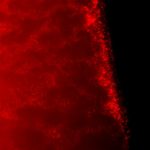Lien vers Pubmed [PMID] – 17077146
Proc. Natl. Acad. Sci. U.S.A. 2006 Nov;103(45):16965-70
Nicotinic acetylcholine receptors (nAChR) are pentameric ligand-gated ion channels composed of subunits that consist of an extracellular domain that carries the ligand-binding site and a distinct ion-pore domain. Signal transduction results from the allosteric coupling between the two domains: the distance from the binding site to the gate of the pore domain is 50 A. Normal mode analysis with a C(alpha) Gaussian network of a new structural model of the neuronal alpha7 nAChR showed that the lowest mode involves a global quaternary twist motion that opens the ion pore. A molecular probe analysis, in which the network is modified at each individual amino acid residue, demonstrated that the major effect is to change the frequency, but not the form, of the twist mode. The largest effects were observed for the ligand-binding site and the Cys-loop. Most (24/27) of spontaneous mutations known to cause congenital myasthenia and autosomal dominant nocturnal frontal lobe epilepsy are located either at the interface between subunits or, within a given subunit, at the interface between rigid blocks. These interfaces are modified significantly by the twist mode. The present analysis, thus, supports the quaternary twist model of the nAChR allosteric transition and provides a qualitative interpretation of the effect of the mutations responsible for several receptor pathologies.
